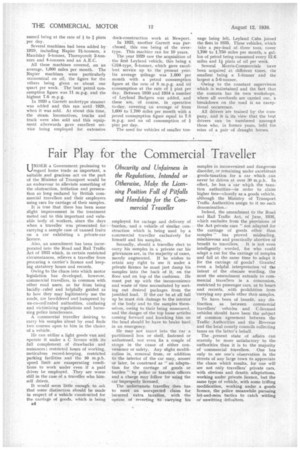Fair Play for the Commercial Traveller
Page 38

If you've noticed an error in this article please click here to report it so we can fix it.
Obscurity and Unfairness in the Regulations, Intended or Otherwise, Make the Licensing Position Full of Pitfalls and Hardships for the Com mercial Traveller
UINDER a Government professing to %...lregard home trade as important, a suitable and gracious act on the part of the Minister of Transport would be an endeavour to alleviate something of the obstruction, irritation and persecution so long endured by British commercial travellers and their employers using cars for carriage of their samples.
It is true that there has been some slight improvement in the treatment meted out to this important and valuable body of workers, since the days when a traveller was prosecuted for carrying a sample case of canned fruits on a car exhibiting a private-car licence.
Also, an amendment has been incorporated into the Road and Rail Traffic Act of 1933 which, in certain restricted circumstances, relieves a traveller from procuring a carrier's licence and keeping statutory hours and records, Owing to the chaos into which motor legislation has developed, however, commercial travellers, in common with other road users, so far from being lucidlyruled and helpfully guided as to how they may legitimately use the roads, are bewildered and hampered by un-co-ortEnated authorities, confusing and victimizing regulations and harassing police interference.
A commercial traveller desiring to carry his samples about by road finds two courses open to him in the choice of a vehicle.
He can utilize a light goods van and operate it under a C licence with its full complement of drawbackS and nuisances ; restricted hours of working, meticulous record-keeping, restricted parking facilities and the 30 m.p.h. speed limit are exasperating conditions to work under even if a paid driver be employed. They are worse still in the case of a traveller who himself drives.
It would seem little enough to ask that some distinction should be made in respect of a vehicle constructed for the carriage of goods, which is being B4 employed for cartage and delivery of burden, and a vehtiole of similar construction which is being used by a commercial traveller exclusively for himself and his samples.
Secondly, should a traveller elect to carry his samples in a private car his grievances are, in the majority of cases, merely augmented. If he wishes to retain any right to use it under a private licence he must just dump his samples into the back of it, on the floor and on top of the cushions. He must put up with the inconvenience and waste of time necessitated by sorting out desired packages from the jumbled load. If the car be at all full up be must risk damage to the interior of the body and to the samples themselves, owing to their being unsecured, and the danger of the top loose articles coming forward and knocking him on the head should he have to brake hard in an emergency.
He may not insert into the car a partitioned box or shelf, fastened or unfastened, nor even fix a couple of straps in the cause of either convenience or safety. Any slight modification in, removal from, or addition to the interior of the car may, sooner or later, be construed as " an adaptation for the carriage of goods or burden " by police or taxation officers and a charge may follow for using the car improperly licensed.
The unfortunate traveller then has to meet an unexpected claim for incurred extra taxation, with the option of reverting to carrying his samples in inconvenient and dangerous disorder, or remaining under exorbitant goods-taxation for a car which can never be driven at over 30 m.p.h. In effect, he has a car which the taxation authorities—in order to claim higher fees—classify as a goods vehicle, although the Ministry of Transport Traffic Authorities assign to it no such denomination.
Indeed, the amendment to the Road and Rail Traffic Act, of June, 1036, which excludes from the provisions of the Act private cars " not adapted for the carriage of goods other than samples " has proved misleading, mischievous and practically abortive of benefit to travellers. It is not even intelligently worded, for who could adapt a car for the carriage of samples and fail at the same time to adapt it for the carriage of goods? Granted even a helpful interpretation -of the intent of the obscure wording, the most the amendment extends to commercial travellers is a concession, restricted to passenger cars, as to hours and records, with prohibition from 'carrying any goods other than samples.
To have been of benefit, any distinction as between commercial travellers' vehicles and C-licensed vehicles should have been the subject of common agreement between the Traffic Authorities and the Revenue and the local county councils collecting taxes on the latter's behalf.
The .present state of affairs can scarcely be more satisfactory to the authorities than it is to the majority of commercial travellers. One has only to use one's observation in the streets of any large town to appreciate the chaos which results, for one will see not only travellers' private cars, with obvious and drastic adaptations, working under private licence, but the same type of vehicle, with some trifling modification, working under a goods licence, the police meanwhile pursuing hit-and-miss tactics to catch witting or: unwitting defaulters.




















































































